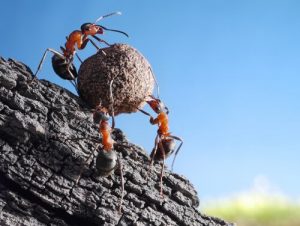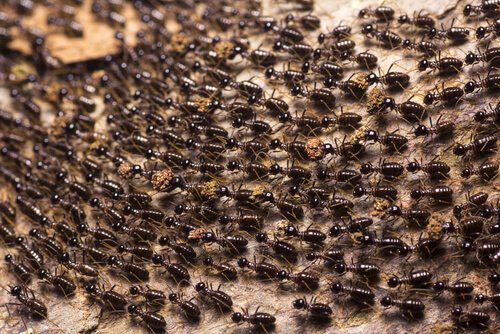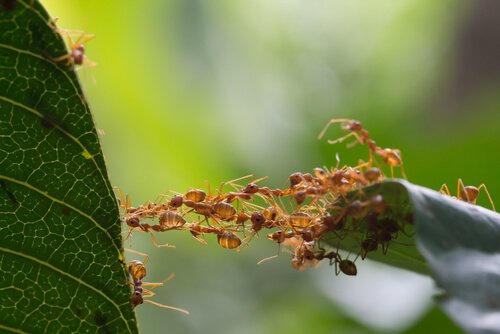Here are Some Fascinating Fun Facts About Ants

These tiny little creatures can be extremely annoying when summer hits. However, there are also tons of amazing fun facts worth knowing about ants. For example, they’re actually extremely organized, and you can turn them from a household enemy into an ally.
Fun facts about ants
They’ll eat anything
Even though they’re tiny, they’re predators for just about all animals and plants. They can eat an entire mammal, although it takes them a few months. Even fish sometimes end up being part of their diet.
They have a super long life expectancy
An ant can live between 4-12 years. That’s an insanely long life for such an insignificant looking creature. Who would have ever thought of that? Maybe, year after year, it’s always the same ants marching through your kitchen.
Their communication skills
Ants don’t make sounds, no wonder the human ear can’t pick up on them. The main way they communicate is by leaving behind bits of the things they’ve picked up along their way. This is how the rest of their group knows where to find them at any given moment.

They can also use their antennae to communicate. They do it by brushing them up against another ant.
They’re strong
This is probably one of the most well-known fun facts about ants, but we’ll mention it just in case. They can lift up to 50 times their own weight. So, how much do you weigh? 160 pounds? Multiply that by 50 and ask yourself if you could lift that weight entirely on your own. It sounds much more amazing now, doesn’t it?
The queen ant
The queen ant lays eggs so the colony will prosper. She can lay up to 800-1,500 per day. Now you probably see why you can see 1 ant one day, then a million the next.
They have servants
Yep, you read that right. They often enslave other ants and have them do all the work or work alongside the rest so that they can finish faster. It doesn’t matter whether they come from the same colony or not.
They like the water
It could be because they like water or the other way around, but either way, an ant can live up to two weeks underwater. So, if you have an ant infestation at home, water won’t be too helpful.
The largest colony ever
One major trait about ants is that they live in colonies. The biggest colony ever recorded was discovered in 2002. Millions of ants lived in the colony, which was over 4,000 miles long.

Their brain
Ants have the largest brain in proportion to their body of any other animal.
Strength in numbers
People often talk about them like a plague. Honestly, that definition does hit the mark in at least one way. It’s estimated that about 10% of the total mass of the animal kingdom is made up of ants. Stop for a second and think about what that really means…
They always fall to the…
We don’t know why, but if you use insecticide on them, they seem to always fall to the right.
Ants have a predator
There’s a kind of insect called an “antlion” that primarily eats ants. But supposedly ants have been known to come up with strategies to defeat their mortal enemy.
They make bridges
If they ever run into a gap while they’re going about their duties, they efficiently grab on to each other and make a bridge so that the rest of the colony can get across. Once all the ants have made it, they undo the bridge one ant at a time.

The way they hunt
Ants also eat other insects. When they capture an alive prey, the first thing they do is make sure it can’t move. They latch on to each other to hold it down by the feet. If it’s venomous, they cover it in a kind of bag that they make on the spot.
Well, that’s all the fun facts we have about ants. These little creatures are full of secrets and wonders, and we hope you’ve enjoyed learning a bit more about them!
These tiny little creatures can be extremely annoying when summer hits. However, there are also tons of amazing fun facts worth knowing about ants. For example, they’re actually extremely organized, and you can turn them from a household enemy into an ally.
Fun facts about ants
They’ll eat anything
Even though they’re tiny, they’re predators for just about all animals and plants. They can eat an entire mammal, although it takes them a few months. Even fish sometimes end up being part of their diet.
They have a super long life expectancy
An ant can live between 4-12 years. That’s an insanely long life for such an insignificant looking creature. Who would have ever thought of that? Maybe, year after year, it’s always the same ants marching through your kitchen.
Their communication skills
Ants don’t make sounds, no wonder the human ear can’t pick up on them. The main way they communicate is by leaving behind bits of the things they’ve picked up along their way. This is how the rest of their group knows where to find them at any given moment.

They can also use their antennae to communicate. They do it by brushing them up against another ant.
They’re strong
This is probably one of the most well-known fun facts about ants, but we’ll mention it just in case. They can lift up to 50 times their own weight. So, how much do you weigh? 160 pounds? Multiply that by 50 and ask yourself if you could lift that weight entirely on your own. It sounds much more amazing now, doesn’t it?
The queen ant
The queen ant lays eggs so the colony will prosper. She can lay up to 800-1,500 per day. Now you probably see why you can see 1 ant one day, then a million the next.
They have servants
Yep, you read that right. They often enslave other ants and have them do all the work or work alongside the rest so that they can finish faster. It doesn’t matter whether they come from the same colony or not.
They like the water
It could be because they like water or the other way around, but either way, an ant can live up to two weeks underwater. So, if you have an ant infestation at home, water won’t be too helpful.
The largest colony ever
One major trait about ants is that they live in colonies. The biggest colony ever recorded was discovered in 2002. Millions of ants lived in the colony, which was over 4,000 miles long.

Their brain
Ants have the largest brain in proportion to their body of any other animal.
Strength in numbers
People often talk about them like a plague. Honestly, that definition does hit the mark in at least one way. It’s estimated that about 10% of the total mass of the animal kingdom is made up of ants. Stop for a second and think about what that really means…
They always fall to the…
We don’t know why, but if you use insecticide on them, they seem to always fall to the right.
Ants have a predator
There’s a kind of insect called an “antlion” that primarily eats ants. But supposedly ants have been known to come up with strategies to defeat their mortal enemy.
They make bridges
If they ever run into a gap while they’re going about their duties, they efficiently grab on to each other and make a bridge so that the rest of the colony can get across. Once all the ants have made it, they undo the bridge one ant at a time.

The way they hunt
Ants also eat other insects. When they capture an alive prey, the first thing they do is make sure it can’t move. They latch on to each other to hold it down by the feet. If it’s venomous, they cover it in a kind of bag that they make on the spot.
Well, that’s all the fun facts we have about ants. These little creatures are full of secrets and wonders, and we hope you’ve enjoyed learning a bit more about them!
All cited sources were thoroughly reviewed by our team to ensure their quality, reliability, currency, and validity. The bibliography of this article was considered reliable and of academic or scientific accuracy.
Lowe, S., Browne, M., Boudjelas, S., & De Poorter, M. (2004). 100 de las especies exóticas invasoras más dañinas del mundo Una selección del Global Invasive Species Database. Aliens.
Delabie, J. H. C., Ospina, M., & Zabala, G. (1996). Relaciones entre hormigas y plantas : una introducción. Introdución a Las Hormigas de La Región Neotropical. https://doi.org/10.1108/EUM0000000005647
Fernández, F. (2003). Breve introducción a la biología social de las hormigas. Fernandez, F. https://doi.org/10.1108/EUM0000000005647
This text is provided for informational purposes only and does not replace consultation with a professional. If in doubt, consult your specialist.








